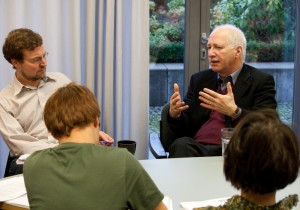
The second lecturer that was invited to enrich the discussions of the PY Core Progamme – dedicated to the relationship between vision and knowledge – was the distinguished professor and intellectual historian Martin Jay. For three hours of entertaining and fertile thought, Martin Jay presented ideas from one of his yet to be published articles, followed by an inspiring discussion related to previous aspects of his work and ways to expand it further.
The lecture was based on a work in progress, The Scopic Regime of Modernity Revisited, where Professor Jay returns to some of his previous ideas in order to ask what we can now say, twenty years later, about the concept of “scopic regime” as a critical tool of analysis. The term was first coined by Christian Metz in his book The Imaginary Signifier and was used then solely to distinguish between cinema and theatre, superseding the distinction between cultural and technological.
Although the concept of “scopic regimes” was familiar to film theory due to Metz, it was Martin Jay’s essay published in 1988 in a collection on “Vision and Visuality” that brought it into the other intellectual discourse as well. In his study, Professor Jay inflates the meaning of the concept so to encompass three different regimes of modernity, where vision and knowledge meet and influence one another.
It was an enterprise inspired by the question raised by Martin Heidegger in his seminal work The Age of Image Picture, whether every age has a world picture (Weltbild) or whether this feature is characteristic only to Modernity?
The concept of Weltbild comprises a relation between vision and knowledge that was lost in Dilthey’s Weltanschaung. It also suggests a distinction between objects that can be conceived and grasped as image, as opposed to a subject that views them. The constitution of world in image emerged only in Modernity. It was brought about by a radical opposition between the viewing subject and the viewed object, originating in Descartes’ split of the subject and also in an attitudinal shift that no longer viewed curiosity as a vice.
In his talk, Martin Jay proposed Heidegger’s assumption to be too limiting and invited not only to distinguish between three concomitant regimes of modernity– with that of Baroque reason and Dutch descriptivism standing beside Cartesian perspectivalism- but also to enquire about a possible range of applications for the concept in terms of scale, given the new division between macro and microscopic.
Martin Jay (born 1944) is the Sidney Hellman Ehrman Professor of History at the University of California, Berkeley and current fellow of the American Academy in Berlin. His most influential publications include The Dialectical Imagination (1973;1996); Marxism and Totality (1984); Force Fields (1993), Downcast Eyes: The Denigration of Vision in Twentieth-Century French Thought (2003), Cultural Semantics: Keywords of the Age Refractions of Violence (2003), Songs of Experience (2004).
Currently, Martin Jay is working on his new project Magical Nominalism: Photography and the Reenchantment of the World.
by Diana Martin/Logan Woods (PY ’11, Romania/USA)
